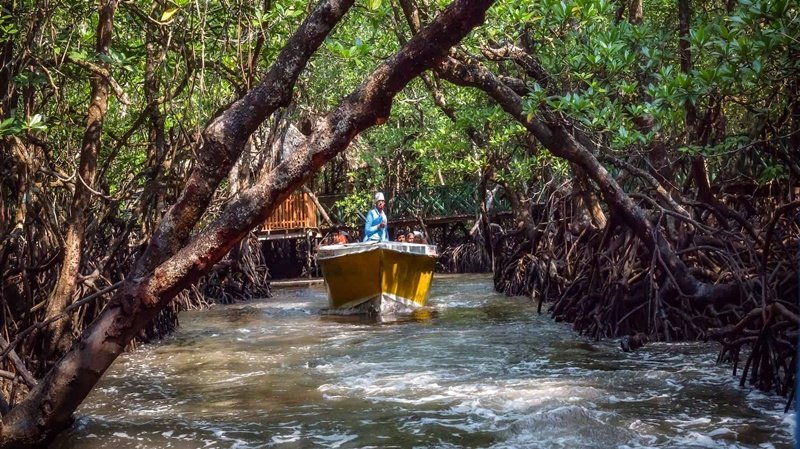Baratang Island




Explore
Baratang Island
Enjoy the beautiful Limestone caves and mangroves
🌴 Baratang Island – Overview
Location: ~100–110 km north of Port Blair, nestled between Middle and South Andaman.
Administrative Division: Part of the North & Middle Andaman District.
Area: Approximately 243 sq. km.
Famous For: Limestone caves, mud volcanoes, mangrove forests, and tribal reserves.
Ideal For: Nature lovers, geology enthusiasts, and offbeat travelers.
🕰️ History of Baratang Island
Early History
Originally inhabited by indigenous Jarwa tribes, part of the Great Andamanese group.
The island remained untouched by modern development for centuries.
Colonial Era
The British established a limited presence here, mostly for resource extraction and monitoring the indigenous tribes.
The Jarwas maintained hostile isolation to outsiders during this time.
Post-Independence
The Indian government encouraged Bengali, Tamil, Telugu, and Ranchi settlers to cultivate and inhabit some parts of the island.
A major road (Andaman Trunk Road) was constructed through Jarwa tribal territory, which remains a matter of ongoing concern and conservation.
🌍 Culture of Baratang Island
Inhabitants
Jarwa Tribes: Semi-nomadic indigenous people who live in protected forest reserves. Contact with them is strictly prohibited by law.
Settlers: Mostly Bengali, Telugu, Tamil, and tribal groups from mainland India brought in as part of rehabilitation schemes.
Language
Hindi, Bengali, Telugu, Tamil, and Andamanese dialects (within the tribal reserve) are spoken.
English is used for tourism and official communication.
Lifestyle
Life is simple and rural, revolving around fishing, farming, and tourism.
Sustainable practices are common due to limited resources.
🏞️ Top Tourist Attractions in Baratang Island
1. 🕳️ Limestone Caves
One of Baratang’s main highlights.
Accessible via a short boat ride through thick mangrove creeks followed by a walk through the forest.
The caves are made of sedimentary limestone, forming stunning stalactites and stalagmites over thousands of years.
A guided tour is recommended to understand the cave’s formations and geology.
2. 🌋 Mud Volcano
The only active mud volcanoes in India are found here.
Mud rather than lava erupts slowly due to underground gas emissions.
Located about 6–7 km from Baratang Jetty; can be accessed by a short trek.
Not visually dramatic but geologically fascinating.
3. 🌿 Mangrove Creek
The boat ride to Limestone Caves through interwoven mangrove tunnels is an unforgettable experience.
Peaceful, bird-filled journey great for photography and nature lovers.
4. 🏖️ Baludera Beach
Quiet and uncrowded.
Known for its shallow waters, clean sands, and elephant sightings in earlier days.
Great for a picnic or sunset viewing.
5. 🚙 Andaman Trunk Road & Tribal Reserves
The ATR passes through the Jarwa Reserve Forest.
Travelers may spot Jarwa tribes along the route, though photography, stopping, or interaction is strictly forbidden by law.
The drive is escorted in convoys with forest department and police oversight to protect the tribe’s privacy and safety.
🚫 Important Note: Any attempt to photograph or interact with the Jarwa people is a serious offense under the Andaman & Nicobar Protection of Aboriginal Tribes Regulation (ANPATR), 1956.
🛶 Adventure and Activities in Baratang Island
1. Mangrove Kayaking (Seasonal)
In recent years, eco-kayaking tours through mangrove creeks are being introduced.
Ideal for eco-tourists and bird watchers.
2. Trekking
Short jungle treks to Limestone Caves and Mud Volcano are accessible to all age groups.
Treks are under forest department supervision.
🦐 Cuisine and Food in Baratang Island
Baratang is a rural island, so food options are simple but satisfying.
Local Delicacies
Seafood curries made with coconut, mustard, and local spices.
Rice and lentils, fried vegetables, and chutneys.
Dishes from Bengali and South Indian cuisines dominate.
Where to Eat
Few local dhabas and basic restaurants near Baratang Jetty.
Food is homely; don’t expect fine dining or international cuisine.
Some government guest houses offer basic meals to tourists.
⚠️ Tip: Carry snacks, bottled water, and packed meals if you plan a full-day trip, as options are limited.
🏨 Where to Stay in Baratang Island
Baratang is more of a day-trip destination, but some basic accommodation is available for overnight stays.
Government and Forest Guest Houses
APWD and Forest Department Rest Houses (Booking required in advance via the tourism office).
Eco Resorts and Homestays
Dew Dale Resorts – Mid-range option with clean rooms and local cuisine.
TAPOVAN Resorts – Simple stay, good for overnight trips.
🛑 No luxury resorts or hotels on the island. It’s best suited for nature travelers and backpackers.
🛍️ Shopping on Baratang Island
Not a commercial shopping hub.
A few local stalls sell:
Coconut handicrafts
Dried fish
Small souvenirs
Major shopping is best done in Port Blair.
🛫 How to Reach Baratang Island
By Road from Port Blair (~100–110 km, 4–5 hours)
Travel by Andaman Trunk Road (ATR).
Compulsory forest convoy crosses Jarwa Reserve at fixed timings:
First convoy starts around 6:00 AM from Jirkatang check post.
Total 4 convoys daily; timing must be followed strictly.
Stops at Middle Strait, then a vehicle ferry carries cars and passengers to Baratang.
By Private Taxi or Bus
Taxis can be hired from Port Blair.
Government and private buses operate too, but are less comfortable.
📅 Best Time to Visit Baratang Island
October to May: Ideal weather, clear skies, and open forest roads.
Avoid Monsoon (June to September): Landslides, muddy paths, and closed caves due to flooding.
⚠️ Travel Guidelines and Permissions
No special permit needed for Indian tourists.
Foreign nationals are not permitted to visit Baratang due to its proximity to tribal reserves.
Photography and filming in tribal areas are strictly prohibited.
🌿 Sustainability and Conservation
Baratang lies in an ecologically sensitive zone.
Forest department controls access to protect coral reefs, mangroves, and tribal rights.
Tourists are encouraged to:
Avoid plastics
Stay within designated paths
Respect local culture and environmental rules
🧭 Suggested Itinerary (Day Trip from Port Blair)
5:00 AM – Depart from Port Blair
7:00 AM – Cross Jirkatang forest gate in convoy
9:00 AM – Ferry to Baratang
10:00 AM – Visit Limestone Caves
12:30 PM – Explore Mud Volcano
2:00 PM – Lunch and rest near jetty
3:00 PM – Return via convoy
7:00 PM – Back in Port Blair
🔚 Conclusion
Baratang Island is a hidden gem in the Andaman Islands that offers a raw, untouched experience of nature — far from the commercial beaches of Havelock or Neil. With its natural limestone caves, rare mud volcanoes, mangroves, and proximity to tribal areas, it offers a unique blend of geology, ecology, and anthropology.
It’s best suited for:
Eco-tourists
Geology and nature enthusiasts
Curious travelers looking for offbeat destinations
